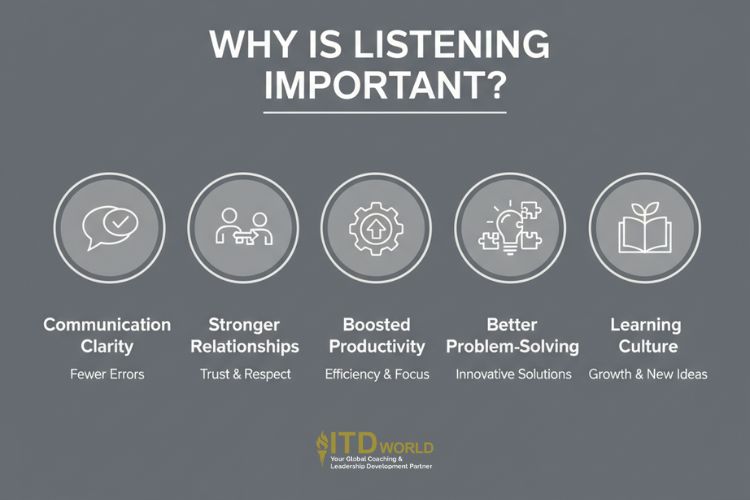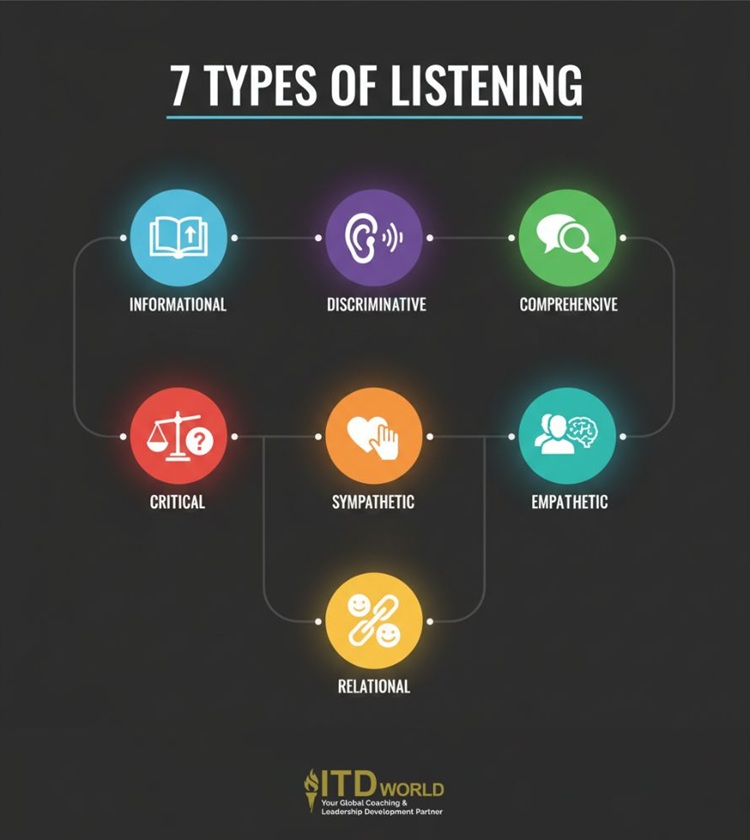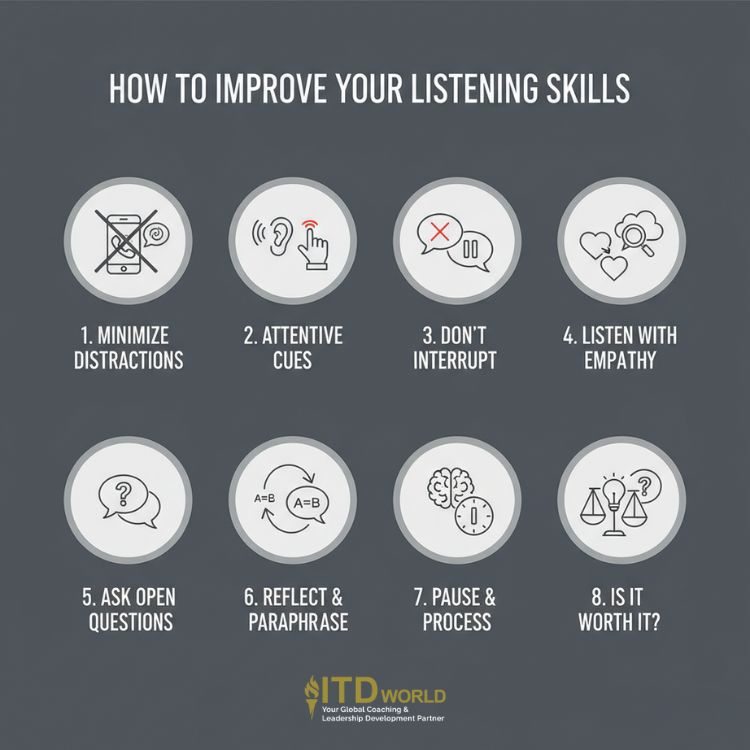Learn the importance of listening, how it contributes to stronger workplace bonds, enhances leadership & facilitates success!
Listening is a skill often overshadowed in the daily rush, yet it stands as the bedrock of meaningful workplace connections – a quiet catalyst for individual and team success. This article delves into the importance of listening in its entirety – from defining what active, engaged listening truly entails and why it’s indispensable for building strong bonds and effective leadership, to understanding its various forms, the common barriers that prevent us from doing it well, and the practical, expert-backed strategies you can adopt to cultivate it.
|
Author: Jonathan M. Pham |
Highlights
- Unlike hearing, listening is an active, conscious process of receiving, interpreting, and deeply understanding messages, encompassing both verbal and non-verbal cues.
- Listening is crucial for effective communication and meaningful connections; it enhances clarity, builds trust, boosts productivity, facilitates problem-solving and innovation, and fosters a culture of continuous learning within organizations. For those in leadership positions, this skill enables them to better make informed decision-making, boosts employee engagement, unlock team innovation, and strengthen their influence.
- There are 7 types of listening at work – namely informational, discriminative, comprehensive, critical, sympathetic, empathetic/therapeutic, and relational – each serving distinct purposes.
- We often fail to truly listen due to the pressure to respond quickly, internal and external distractions, neglecting non-verbal cues, succumbing to biases and emotional reactions, rehearsing our replies, and providing insufficient feedback.
- To improve listening skills, one should minimize distractions, use attentive non-verbal cues, avoid interrupting, listen with empathy, ask elaborative questions, paraphrase and summarize, pause to process information, and thoughtfully consider the value and impact of their contributions.
What Actually is Listening?
At its core, listening is an active and dynamic process of receiving, interpreting, and deeply understanding the messages others convey. It’s a conscious effort that demands one’s full attention, going beyond merely registering sounds.
True listening involves a commitment to not only absorb the spoken words but also to keenly observe and interpret the non-verbal cues that accompany them. This includes paying close attention to the speaker’s tone of voice, their body language, and subtle facial expressions – all of which contribute vital layers of meaning to their message.
According to the research of Adler, R., Rosenfeld, L. and Proctor, R. on interpersonal communication, the ability to accurately comprehend messages is foundational to effective interaction. Think of it as the skill of meticulously decoding the complete communication package. When this skill is underdeveloped or absent, the door opens to misinterpretations and misunderstandings. These, in turn, breed frustration, erode trust, and ultimately lead to breakdowns in both professional and personal relationships.
Listening is Not the Same as Hearing
While the terms “hearing” and “listening” may be used interchangeably in casual conversation, they represent two distinct concepts. Understanding this distinction is the first step toward harnessing the importance of listening.
Hearing: The automatic perception of sound
Hearing is fundamentally a physiological process. It’s the passive reception of sound waves by the ears. Your auditory system automatically picks up sounds from your environment – the hum of a computer, distant traffic, or even a voice in the room – without any conscious effort on your part. Think of it as your body’s natural ability to detect sound. It’s an involuntary sensory experience.
Example 1: You might hear music playing in a coffee shop while you’re reading a book. The sounds are entering your ears, but you’re not necessarily processing the lyrics or the melody.
Example 2: During a busy workday, you might hear your phone ring or a notification chime, even if you’re engrossed in another task. It’s a sound you perceive.
Listening: The active engagement with meaning
Listening, conversely, transcends the mere perception of sound; it is an active, cognitive, and intentional process. It requires focused attention and conscious effort.
When you listen, you are not just hearing words; you are striving to understand the message being conveyed by processing the information, interpreting nuances, and making sense of both verbal and non-verbal cues.
It encompasses the narrative itself, the specific language and terminology used, the speaker’s vocal intonations (like emphasis or sarcasm), their pace, and their accompanying body language (gestures, posture, eye contact).
Effective listening hinges on one’s ability to perceive, interpret, and comprehend these multifaceted messages to grasp the complete picture.
Example 1: In that same coffee shop, if you decide to focus on the music, identify the instruments, follow the rhythm, and understand the emotions the song evokes, you are listening.
Example 2: When your phone rings and you choose to answer it, pay attention to the caller’s words, understand their purpose for calling, and formulate a relevant response, you are actively listening.
Example 3: Imagine you’re in a team meeting. Hearing might involve registering that someone is speaking. Listening, however, means you’re focused on what they’re saying, trying to understand their perspective on the project, noting their concerns evident in their tone, and considering how their points relate to the overall discussion.

The importance of listening
Unlike an automatic reflex, true listening demands practice and intentionality. It is a cultivated skill that can be refined with conscious effort or, conversely, can diminish if neglected. This active engagement is what transforms simple auditory input into meaningful understanding, paving the way for better collaboration and outcomes.
Listening is not the act of hearing the words spoken; it is the art of understanding the meaning behind those words.
Simon Sinek
| Feature | Hearing | Listening |
| Nature | Physiological, sensory |
Cognitive, intellectual, emotional
|
| Process | Passive, automatic, involuntary |
Active, intentional, voluntary
|
| Attention | Minimal or no focused attention required |
Requires conscious focus and concentration
|
| Focus | Perceiving any and all sounds in the vicinity |
Comprehending specific messages, both verbal and non-verbal
|
| Involvement | Physical presence of sound |
Mental processing, interpretation, and understanding
|
| Outcome | Awareness of sound |
Understanding, learning, connection, informed response
|
| Skill Level | A basic human sense |
A learned and cultivated skill
|
| Example | Background chatter in an office |
Engaging in a performance review to understand feedback
|
Why is Listening So Important?
Listening serves as a foundational pillar for effective communication and meaningful connection. The importance of listening cannot be overstated; it’s far more than a passive courtesy – it’s an active skill that unlocks understanding, fuels collaboration, and drives tangible results, particularly in a workplace environment.
Adeptness at listening allows us to not only hear words but also to comprehend the deeper meanings, intentions, and emotions behind them. As such, we are better equipped to formulate relevant responses, fostering richer exchanges of thoughts and ideas while significantly minimizing the likelihood of costly misinterpretations and conflicts.

- Enhances communication clarity and reduces errors
When team members truly listen, they grasp instructions more accurately, understand project goals more thoroughly, and are less likely to make errors stemming from miscommunication. In fact, studies have indicated that a significant portion of workplace mistakes may be traced back to poor listening. For instance, an estimate suggests that Fortune 500 companies might lose billions each year due to inadequate communication and misunderstandings, a large part of which is attributed to ineffective listening.
- Builds stronger relationships and trust
When employees feel heard, they feel respected and valued. This fosters trust, strengthens interpersonal bonds, and creates a more positive and supportive work environment.
Research consistently shows a strong correlation between feeling listened to and employee morale and engagement. For example, a study found that employees who feel their voice is heard are 4.6 times more likely to feel empowered to perform their best work. This sense of psychological safety encourages open dialogue and stronger team cohesion.
- Boosts productivity and performance
The skill of listening is especially crucial in professional collaborations, where effective communication directly impacts productivity. Misunderstandings born from poor listening lead to wasted time, duplicated efforts, and missed deadlines. Conversely, when listening is prioritized, tasks are completed more efficiently, and overall team performance improves.
Research by Deloitte highlighted that companies with effective communication practices (where listening is key) are 50% more likely to have lower employee turnover. Retaining talent, in turn, positively impacts productivity and reduces hiring and training costs.
- Facilitates better problem-solving and innovation
Complex challenges require diverse perspectives. Let’s revisit the scenario of a cross-functional team tasked with a complex project:
Scenario 1 – Ineffective Communication & Poor Listening: Imagine some team members approach problem-solving primarily to showcase their own ideas. They frequently interrupt, speak over others, and dismiss colleagues’ input without full consideration. This behavior, rooted in a failure to listen, inevitably leads to frustration, stifled creativity, a lack of synergy, and suboptimal solutions. Valuable insights are lost, and the team’s collective intelligence is underutilized.
Scenario 2 – Effective Communication Through Active Listening: Now, imagine a team where members actively and attentively listen to each other’s perspectives. They ask clarifying questions, paraphrase to ensure understanding, and make a conscious effort to appreciate different viewpoints before formulating their own responses. As a result, everyone feels valued and respected. This environment nurtures more comprehensive discussions, encourages the safe sharing of novel ideas, and ultimately leads to more innovative and robust solutions.
The importance of listening here is evident as it unlocks collective intelligence.
- Cultivates a culture of continuous learning and development
Being genuinely open to receiving others’ input – whether it’s feedback, new information, or different perspectives – is crucial for fostering curiosity. This openness encourages experimentation with new approaches, helps individuals identify their own blind spots, and ultimately expands their horizons and skill sets.
In essence, listening in the workplace translates into a more efficient, harmonious, innovative, and ultimately more successful organization. It’s an investment in human capital that pays significant dividends.
The importance of listening
The Importance of Listening as a Leadership Skill
While effective listening benefits every individual, the importance of listening takes on even greater significance when examining the qualities of impactful leadership. For a leader, listening transcends a simple communication tactic; it becomes a cornerstone of their ability to inspire, influence, and guide their teams effectively. In today’s complex business environment, leaders who master the art of listening are not just better communicators—they are more effective, empathetic, and ultimately more successful.
- Cultivates deep trust and psychological safety
When leaders actively listen to concerns, ideas, and feedback without premature judgment, they signal that every voice is valued. Not only does it make employees feel respected; it creates an environment where team members are comfortable speaking up, sharing dissenting opinions, and flagging potential issues—critical components for a healthy and high-performing team.
- Enables informed decision-making
Leaders are constantly tasked with making critical decisions. Those who listen broadly and deeply before deciding have a distinct advantage. By actively soliciting and absorbing diverse perspectives from their team members—who often have a closer view of operational realities or customer experiences—leaders gain a more comprehensive understanding of any given situation. This allows for more holistic, well-rounded, and empathetic decisions that consider various impacts and potential outcomes, rather than relying on a limited viewpoint.
- Boosts employee engagement, morale, and retention
Organizations with leaders who are perceived as good listeners tend to experience lower turnover rates – and for good reasons. When employees feel their leader genuinely cares about their input and well-being (often demonstrated through attentive listening), their morale and motivation significantly increase. This sense of being heard and valued is a key driver in job satisfaction and loyalty.
- Unlocks team innovation and agility
Innovation thrives in environments where ideas are freely shared and explored. Leaders who are exceptional listeners create such spaces. By attentively hearing out new, sometimes unconventional, ideas from their team, they encourage creativity and experimentation; hence, they are better equipped to identify promising opportunities and potential roadblocks early on.
During times of change or uncertainty, a leader’s ability to listen to anxieties and suggestions plays a crucial role in making the entire team more adaptable and resilient.
Read more: Leading Through Uncertainty – How to Navigate Turbulent Times
- Strengthens influence and inspires action
Leaders who listen don’t just hear words; they understand the underlying motivations, aspirations, and concerns of their people – which allows them to tailor their communication, articulate a more compelling vision, and connect with their team on a more meaningful level. As a result, their ability to inspire action and rally the team towards common goals is significantly amplified.
The importance of listening in leadership
Read more: 7 Leadership Mistakes to Avoid – From Failure to Success
7 Types of Listening at Work
The importance of listening is magnified when we are aware of and able to adapt our listening style to suit different situations and objectives.
-
Informational listening
- Focus: To accurately grasp, learn, and retain new information or instructions.
- Characteristics: Requires concentration, comprehension, and the ability to identify key points. Critical thinking may be involved to contextualize new knowledge.
- Workplace Example: Attending a training session on a new software system, carefully listening to a project briefing from a manager, or learning about updated company policies during a team meeting.
- Benefit: Ensures tasks are performed correctly, facilitates effective learning and knowledge acquisition, and minimizes errors due to misunderstood information.
-
Discriminative listening
- Focus: To distinguish between sounds and interpret underlying meanings conveyed through non-verbal cues, such as tone of voice, pace, and emphasis, even before processing the actual words.
- Characteristics: The most basic form of listening, often subconscious, helping us sense the speaker’s emotional state or intent.
- Workplace Example: Noticing a colleague’s hesitant or strained tone of voice when they agree to a tight deadline, which might suggest underlying concerns or stress despite their affirmative words; or sensing a client’s enthusiasm or skepticism during a sales pitch based on their vocal energy before they explicitly state their position.
- Benefit: Helps in understanding the subtle, often unspoken, emotional context of a message, allowing for more attuned responses and better interpersonal sensitivity.
-
Comprehensive listening
- Focus: To understand the overall message the speaker is trying to convey by processing their words and language.
- Characteristics: Relies on vocabulary and language proficiency. It’s about making sense of the literal meaning of the words and sentences.
- Workplace Example: Following day-to-day instructions from a supervisor, understanding the core content of a presentation, or getting directions for a specific task from a colleague.
- Benefit: Forms the foundation for understanding what is being communicated, allowing for appropriate follow-up actions or further, deeper listening.
-
Critical listening
- Focus: To analyze, evaluate, and form judgments about the credibility, logic, and merit of the information being presented.
- Characteristics: Involves a deeper level of engagement than comprehensive listening, employing critical thinking and logical reasoning to assess the arguments and evidence.
- Workplace Example: Assessing a vendor’s sales proposal by scrutinizing their claims and data, participating in a strategic planning session by evaluating the pros and cons of different approaches, or reviewing a team member’s project plan to identify potential flaws or areas for improvement.
- Benefit: Leads to more informed decision-making, effective problem-solving, identification of biases or fallacies, and the ability to avoid being swayed by flawed arguments.
-
Sympathetic listening
- Focus: To understand and acknowledge the speaker’s feelings and emotions, primarily to offer support and show care.
- Characteristics: The listener is primarily concerned with the speaker’s emotional state rather than the factual details of the message alone.
- Workplace Example: Comforting a team member who is visibly upset about a challenging project setback, expressing concern when a colleague shares feelings of work-related stress, or offering encouragement after a disappointing outcome.
- Benefit: Builds rapport, fosters a supportive and caring work environment, and makes colleagues feel validated on an emotional level.
-
Empathetic or therapeutic listening
- Focus: To deeply understand the speaker’s feelings, thoughts, experiences, and perspective by endeavoring to see the situation from their point of view.
- Characteristics: Goes beyond sympathy to try and share the emotional experience of the speaker. It involves a higher level of emotional connection.
- Workplace Example: A manager striving to know an employee’s reasons for a dip in performance by trying to see the work challenges and personal pressures from their perspective; or a team member truly grasping a colleague’s frustration with a recurring process issue by imagining themselves facing the same obstacles daily.
- Benefit: Cultivates trust and connection, facilitates more effective conflict resolution, allows for more targeted and meaningful support, and promotes a more inclusive workplace culture.
-
Relational listening
- Focus: To build, maintain, or strengthen interpersonal relationships and connections with the speaker.
- Characteristics: Involves listening to understand the other person on a more personal level, showing interest in them as an individual, and fostering trust and mutual understanding.
- Workplace Example: A team leader actively listening to a team member share their achievements or weekend experiences during an informal chat to build camaraderie; a colleague attentively listening to another’s career aspirations to offer encouragement and support; or engaging in small talk before a meeting to establish a friendly atmosphere.
- Benefit: Leads to stronger team cohesion, improved collaboration, increased employee loyalty, a more positive and open work environment, and enhanced overall communication effectiveness.

Why Do We Often Fail at Listening?
Despite being well aware of the importance of listening, actually doing it effectively, especially in the busy context of the workplace, may prove surprisingly challenging. Many common habits and reactions can get in the way of truly connecting with others.
The “always rushed” syndrome
In today’s fast-paced world, many of us feel pressured to come up with quick responses and solutions. Unfortunately, such a perpetual sense of urgency will sabotage effective listening. When our primary focus is on speed and immediate outcomes, our attention shifts from comprehensively understanding the speaker to formulating our next action or word.
Example: Imagine a team meeting discussing a complex project with a tight deadline. An engineer, Sarah, begins to detail a design challenge, outlining potential obstacles. Before she can fully articulate the issue, colleagues jump in with rapid-fire suggestions: “Why not use a different material?” or “Have you tried another approach?” The conversation quickly becomes a brainstorming session, but Sarah feels her core concerns weren’t fully grasped because the team was too focused on instant solutions rather than deep understanding.
Drowning in distractions (internal and external)
Our ability to listen is constantly under siege from distractions. External distractions are obvious: notifications from our phones, email pop-ups, side conversations, or a noisy office environment. Internal distractions can be just as disruptive: our own wandering thoughts, preoccupations with other tasks, worries, or even daydreaming.
Example: You’re in a one-on-one with a team member who is sharing feedback, but your mind keeps drifting to an urgent email you need to send. Or, your phone buzzes on the table, instinctively drawing your attention away, even if just for a moment, causing you to miss a key part of their message.
Ignoring the unspoken language
A significant portion of communication is non-verbal. Ineffective listeners tend to overlook or misinterpret the rich tapestry of body language, gestures, facial expressions, and tone of voice. These unspoken cues usually convey more than the words themselves and are critical to fully comprehending the message.
Example: Michael is sharing his work frustrations with his colleague, Sarah. As Michael speaks, his posture becomes more animated, his gestures emphasize his points, and his facial expressions clearly show his stress. However, Sarah, while physically present, is scrolling through her phone, offering occasional nods without making eye contact. She misses the intensity in his non-verbal cues, which convey the depth of his distress far more than his words alone. Consequently, Michael feels unheard and unsupported.
The pitfall of preconceived notions (selective/biased listening)
We all have ingrained beliefs, assumptions, and biases. These may lead to selective listening, where we unconsciously pay more attention to information that confirms our existing views and filter out or dismiss contradictory points.
Example: A manager has a long-held belief that traditional marketing methods are always superior. When a junior team member presents a well-researched proposal for a novel digital marketing strategy, the manager finds themselves mentally refuting the points and focusing only on aspects that align with their preference for traditional approaches, thereby missing the potential value of the new idea.
Emotional hijacking
Our own emotions can significantly impair our listening ability. When a speaker’s message triggers a strong emotional response in us (like anger, defensiveness, fear, or even excessive excitement), we might stop listening to understand and instead start formulating a rebuttal, passing judgment, or jumping to conclusions based on our feelings.
Example: In a team coaching session, Alex shares a recent conflict with a colleague, expressing feelings of being hurt. Another participant, Taylor, immediately reacts based on their own strong value for assertiveness, saying, “You should just stand up for yourself! Don’t let them treat you that way.” Taylor’s emotional reaction and eagerness to offer a quick solution prevent them from asking clarifying questions to fully understand Alex’s perspective and the nuances of the situation.
The “What I’ll say next” rehearsal
Instead of focusing on what the other person is saying, we’re busy in our own heads, planning our response, thinking of a clever counter-argument, or waiting for our turn to speak. As such, we’re not truly present and absorbing their complete message.
Example: During a performance review, an employee is receiving constructive feedback. Instead of listening to understand the manager’s points and examples, the employee is mentally listing all the reasons why the feedback might be unfair or preparing justifications, thereby missing the opportunity to fully benefit from the discussion.
The sound of silence (when it’s not golden)
While intentional, reflective silence is a powerful part of listening, consistent unresponsiveness or excessive silence may prove detrimental. If a listener provides no verbal or non-verbal feedback, the speaker may feel ignored, doubt if their message is being received, or interpret the silence negatively (as disinterest, disapproval, or judgment).
Example: A manager has a habit of listening to team members’ updates or suggestions without offering any verbal affirmations, questions, or summarizing statements. Over time, team members become hesitant to share openly, unsure if their input is valued or even being processed, leading to a decline in proactive communication.
Read more: The Power of Apology – How to Say Sorry as a Leader

The importance of listening
How to Improve Your Listening Skill: Things All Good Listeners Do
Becoming a truly effective listener is a journey that requires conscious effort and the cultivation of specific habits. Renowned executive coach Dr. Marshall Goldsmith, in his bestseller “What got you here won’t get you there,” identifies critical practices that distinguish great listeners.
Building on such insights, here are key things all good listeners do to facilitate effective communication and foster positive relationships:
-
Minimize all distractions
Before you can truly listen, you must be present. This means consciously minimizing both external distractions (like phone notifications, email alerts, or a noisy environment) and internal distractions (like your own wandering thoughts or preoccupations). Make a deliberate choice to focus solely on the speaker.
Action: If possible, choose a quiet setting for important conversations. Silence your phone. Close unnecessary tabs on your computer. Mentally clear your agenda for those few moments.
-
Use attentive non-verbal cues
Your body language speaks volumes. Good listeners signal their attentiveness through open and encouraging non-verbal cues, so that the speaker feel acknowledged and more comfortable sharing.
Actions: Maintain appropriate eye contact. Offer nods to show understanding. Orient your body towards the speaker. Use facial expressions that match the speaker’s tone (e.g., concern, interest). Avoid dismissive gestures like looking at your watch or sighing impatiently.
-
Master the art of not interrupting
This is a cornerstone of respectful listening, emphasized by Dr. Goldsmith. Interrupting sends a message that you value your own thoughts more than the speaker’s, or that you’ve already jumped to a conclusion. Instead, allow the speaker to complete their thoughts without cutting them off, even if you think you know what they’re going to say or have an immediate solution.
Action: Make a conscious effort to wait for a natural pause before speaking. If you have a pressing thought, jot it down quickly to address later.
-
Listen with empathy
Empathy is the ability to share the feelings of another. Good listeners strive to see the situation from the speaker’s perspective, acknowledging their emotions and experiences without necessarily having to agree.
Action: Pay attention to the emotional undertones of the message. Ask yourself, “How would I feel in this situation?” or “What is this person truly trying to convey about their experience?”
-
Ask questions that encourage elaboration
Asking thoughtful questions shows you’re engaged and want to understand more deeply. Focus on open-ended questions (those that require more than a “yes” or “no” answer) and clarifying questions to ensure you’re grasping the message accurately.
Actions: Use phrases like, “Can you tell me more about…?” “What did you mean when you said…?” or “How did that affect you?”
Read more: Thoughtful Leadership – Why It Matters in Today’s Hectic World
-
Reflect back: Paraphrase and summarize
To ensure you’ve understood correctly and to show the speaker you’re processing their message, periodically paraphrase their key points or summarize their message.
Actions: Say things like, “So, if I’m understanding correctly, you’re saying that…” or “It sounds like the main challenge is…” This gives the speaker a chance to confirm or clarify.
-
Pause and process
This is another critical technique highlighted by Dr. Marshall Goldsmith. Good listeners control the urge to respond immediately. They take a moment to process what’s been said and to formulate a thoughtful response. This is especially vital when emotions are high.
According to Goldsmith, effective listeners approach conversations as a two-part process: first, actively engaging and paying attention, and then crafting a well-thought-out response. This self-discipline, particularly refraining from speaking out of anger or frustration, leads to more constructive dialogue.
-
Consider your contribution: Is it truly worth it?
Building on the idea of thinking before speaking, Dr. Goldsmith advises asking oneself, “Is it worth it?” before interjecting. Effective listeners evaluate whether their contribution will add value, or if it might inadvertently cause harm, derail the conversation, or make the speaker feel defensive.
Example: Imagine your colleague, John, presents a project proposal. You spot a potential flaw based on your experience. Before speaking, you’d ask yourself:
- Value: Will my insight genuinely add value, or am I just pointing out something minor or trying to sound smart?
- Impact: How can I frame this constructively, offering help rather than criticism? (Empathy is key here – how would I feel?)
- Timing & Dynamic: Is this the right moment, or should I speak with John privately later to avoid disrupting his flow or causing public embarrassment?
By weighing these factors, one may ensure their responses are helpful, respectful, and contribute positively to the relationship and the outcome.

How to improve your listening skills
The importance of listening
Tips for effective listening
Quotes about the Importance of Listening
For those who are interested, check out a full list of listening quotes here!
The most basic of all human needs is to understand and be understood. The best way to understand people is to listen to them.
Ralph Nichols
The word listen contains the same letters as the word silent.
Alfred Brendel
Courage is what it takes to stand up and speak; courage is also what it takes to sit down and listen.
William Arthur Ward
Listening is an art that requires attention over talent, spirit over ego, others over self.
Dean Jackson
When you talk, you are only repeating what you already know. But if you listen, you may learn something new.
Dalai Lama
We have two ears and one mouth so that we can listen twice as much as we speak.
Zeno of Citium

The importance of listening
Final Thoughts on the Importance of Listening
The importance of listening in the workplace is truly undeniable. Becoming a better listener is an ongoing practice, an investment in your professional growth and interpersonal intelligence. By consciously applying the above-mentioned principles, you not only build deeper trust and understanding but also unlock new levels of collaboration, innovation, and leadership.
Other resources you might be interested in:
- Executive Presence: A Complete Guide to Mastery
- Emotional Intelligence (EQ): How to Harness Its Power
- Why Follow Up Matters in Behavior Change & Leadership
- Gratitude in the Workplace: A Reflection on Its Miraculous Power
- Intent vs Impact in the Workplace: How to Close the Gap

